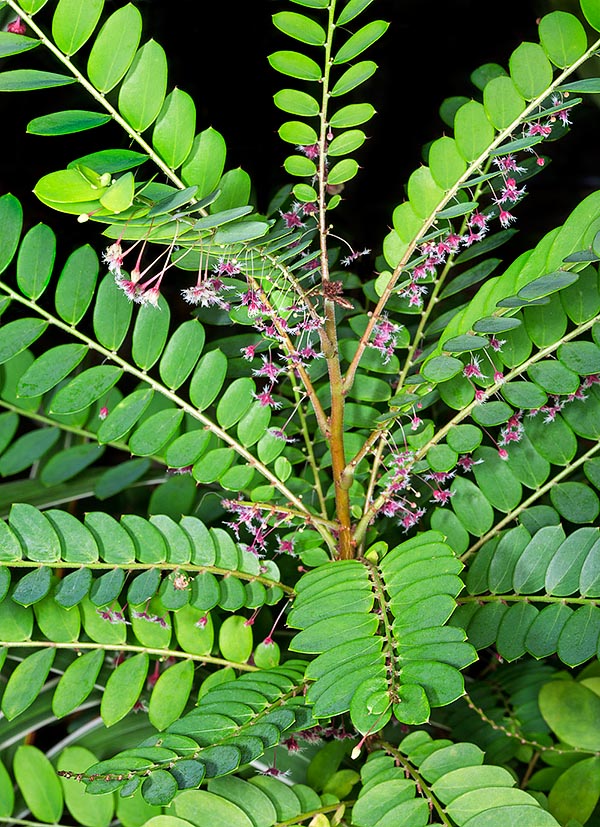Family : Phyllanthaceae

Text © Pietro Puccio

English translation by Mario Beltramini
The species is native to Borneo, Cambodia, China (Guanxi and Yunnan), Java, Laos, Malaysia, Myanmar, Sumatra, Thailand and Vietnam where it grows in the open forests mainly along the banks of water streams, from the sea level up to about 1800 m of altitude.
The generic name is the combination of the Greek substantives “φύλλον” (phyllon) = leaf and “ἄνθος” (anthos) = flower, with reference to the flowers that in some species belonging to the genus generate on the flat stems (cladodes) similar to leaves; the specific name is the Latin adjective “pulcher, chra, chrum” = beautiful, with obvious reference.
Common names: dragon-of-the-world, tropical leaf-flower (English); yun gui ye xia zhu (Chinese); kelurut tanjong, naga buana, semelit patong (Malay); kra thuep yop, toraneesarn (Thai); chó đẻ dáng đẹp, diệp hạ châu đẹp, me dáng đẹp, me lá lệch (Vietnamese).

Originating from Southeast Asia, Phyllanthus pulcher is very decorative shrub with medicinal virtues © Giuseppe Mazza
Axillar inflorescences with unisexual flowers, usually with only one female flower towards the apex of the branch and with one or more male ones towards the base. Male flowers, on a 0,5-1,5 cm long pedicel, with 4 ovate-triangular sepals, 2-3 mm long and 1-2 mm broad, of red purple colour at the base, whitish towards the apex, with fringed margins, and 2 stamina. Female flowers, on a 1,5-2,5 cm long pedicel, with 6 ovate-triangular sepals, 3-4 mm long and 1-1,5 mm broad, with fringed margins, of the same colour as the male ones, subglobose trilocular superior ovary, glabrous, and three styles with bifid apex.
The fruits are subglobose brown capsules, of about 3 mm of diameter, containing usually two trigonal seeds, about 2,5 mm long and 0,4 mm thick.
It usually reproduces by seed in sandy loam maintained humid at the temperature of 24-26 °C; it can propagate also by cutting in spring-summer.
Species cultivated due to the medicinal virtues allocated, in particular in South-East Asia, and as ornamental, due to the foliage and the characteristic blooming almost continuous, in the countries with tropical and subtropical climate, where in some situations has escaped the cultivation behaving as infester. It requires a position preferably in full sun and draining soils rich of organic substance maintained almost constantly humid.
Leaves and roots are since long time utilized in the traditional medicine to alleviate ailments of various nature; laboratory studies have evidenced the presence in the plant of compounds with high cytotoxic activity against various types of cancer, results that have attracted considerable interest among the researchers of the sector.
Synonyms: Epistylium glaucescens Baill. (1858); Epistylium phyllanthoides Baill. (1858); Epistylium pulchrum Baill. (1858); Reidia glaucescens Miq. (1859); Phyllanthus zollingeri var. microphyllus Müll.Arg. (1863); Phyllanthus pallidus Müll.Arg. (1866); Diasperus pallidifolius Kuntze (1891); Diasperus pulcher (Wall. ex Müll.Arg.) Kuntze (1891); Phyllanthus asteranthos Croizat (1940); Phyllanthus lacerilobus Croizat (1944).
→ To appreciate the biodiversity within PHYLLANTHACEAE family please click here.
